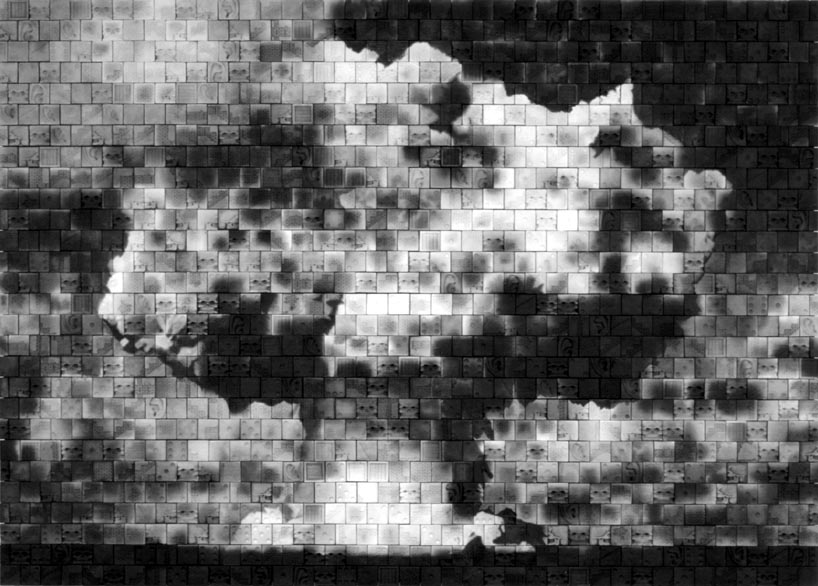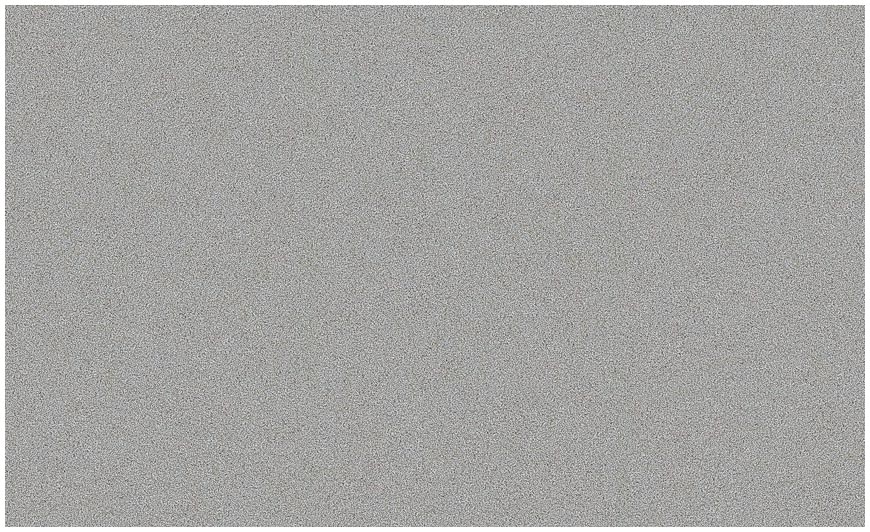
Skull With Cigarette, 2007 [based on a painting by Van Gogh]
98X72"

Close Up Skull With Cigarette, 2007
When I wrote this at 9:36:22pm on March 22, 2009 the US population, according to the Census Bureau, was 306,063,901. For the current population, add 1 person for every thirteen seconds since then. This is the mathematical frame for Chris Jordan's installation up now through the 12th of July at the Portland Art Museum's Apex gallery. The selections from his Running the Numbers series attempts to lay out the statistics from recent American consumerism, creating flawless photomontages that literally depict the specific number e.g. 200,000 packs of cigarettes, equal to the number of Americans who die from cigarette smoking every six months. The works are spotless and overwhelming to the point of becoming specter-like in their meaning, teasing an allegorical omnipresent truth of innocuousness in American consumption.

Richard Notkin, "The Gift" 1999
Forging your way to the top of PAM's south building after finding the correct elevator, you move toward the Northwestern corner of the fourth floor. The first piece that resolves into vision is Skull with Cigarette. As stated above, it is comprised of 200,000 packs of cigarettes that are meticulously composed into a montaged picture based on a painting by Van Gogh. The piece's repetitious utilization of semiotics is very reminiscent of Richard Notkin's The Gift, a 1,106-tile mosaic-montage resulting in a picture of an atomic bomb explosion that is made up of many smaller images of skulls, dice, brain, brick, ears, and more. The larger tiles of Notkin's montage are immediately haunting - like a mental poltergeist. The tiles speak and nudge you as you approach; shouting out "death" and "chance," building an unnerving tension that feels like a ghost of the Cold War after an alternate ending. Jordan's Skull with Cigarette comprised of all too familiar graphic designs from cigarette packages; the melancholy smoking skeleton pixelates into the nostalgic friendliness of a convince store. On the back-burner of your mind is the strangely large quantity and corresponding size - the mammoth amount of cigarette packs creates a slightly queer feeling, as if you could be attacked by legions of ants at any second. Luckily, the thousands of shiny, perfect, static cigarette packs never move. The photo's luster feels as if it has been resin cast one-half second prior death as a title wave's beauty just eclipsed the sun zenith. A similarly strange dialectic strikes upon sight from one half meter. The puzzle placed before you is more enthralling the closer you get mentally as one physically oscillates, like a camera attempting to auto-focus in the dark. Terminal intimacy with the piece has been reached.

Richard Misrach "Untitled #704-03", 2003

Cell Phones, 2007
60x100"
You peek around the wall to the left and see no meta-image - just a texture - like a black and white photo of sand or TV fuzz. The sand-like texture is reminiscent of Richard Misrach's photos taken from his hotel room balcony. The character on the beach has fallen through the sand. Approaching and anticipating the photograph's dissolving effect, wondering if you will fall into the sand yourself; your pace is reduced slowly walking into the sea cell phones - 426,000 to be exact. That is the number of cell phones that the United States retires everyday. Taking a second, catching a breath above the photo, you examine the Pacific of discarded tools. Reluctant to accept such a staggering number, the thought will stick with you until your next cell phone.

Light Bulbs, 2008
72x96"
Continuing clockwise around the space, the next encounter is 320,000 Light Bulbs, each one represents the kilowatt hours of electricity wasted in the United States every minute from inefficient residential electricity usage (two examples are inefficient wiring and computers in sleep mode). This montage looks like a space scape, an exploding supernova of light bulbs or a Hubble snapshot of the origin of the bulb universe. The viewer still is unsure of weather they are witnessing a universal perpetual expansion or contraction. The image is pleasant and awe-inspiring, with an undertone of narrative solicitude. This montage more successfully than the other four of Jordan's works fit into a mental personification of the Matrix hero Neo, the well-dressed white male under the radar strolls into your business lobby with it's skeptical defense agents self-critical attack. The typical roll isn't played out where Neo enters the lobby shooting up our naive reality in a storm of visually assaulting revolutionary bullets, in an effort to saving the hostage us. What happens is more like Neo caught in the act of sneaking something through the metal detector, pulls out some leg weights, places them on you and you walk away. Turning to the right and see very tiny airplanes.

Jet Trails, 2007
60x96"
At this point, some major parts of daily life have been discretely pointed out in a negative light. Now you begin to shut down. The image's amazingly perfect appearance isn't the culprit, but one can only handle so much modern guilt in a day. Seeing 11,000 airplanes, but reading the piece is about their exhaust. The number is equal to the number of commercial flights that pollute the air in the US every eight hours. A battle of economics now starts in your head. Sadly, this battle doesn't have any hard numbers, besides 11,000 flights. Thinking hard about this number, one sad positive to the alterative to airplane flights with seemingly relative certainty that if all of the people on each of those flights were to drive in individual cars to each of their destinations, the pollution would be equal or worse, so in the end I feel that I am dealing with some vicarious energy/pollution dilemma that is beyond full comprehension.

Pain Killers, 2007
60x63"
To the left of the airplanes, I turn - still puzzled - to find a photomontage depicting 213,000 Vicodin pills. Apparently that number is equal to the number of emergency room visits per year in the US due to misuse or abuse of prescription pain killers. At first it seems like a lot, but that number becomes smaller when phrased as less than 1% of population of the US - i.e. 99% of the population managed not to overdose. There is always that one person who passed out for eight hours and loses blood flow to their arm and leg. Then have to make that trip to the emergency room, where they will probably loose their arm and leg. In one day, my perception of the last piece has become real.
Finished with the five Chris Jordan photos that have been selected for this show, you pause and take a deep breath. The show makes you think the real challenge is in relating the unfathomable numbers to an individual level that allows for a deeper conversation that hits home and pulls the numbers out of the stratosphere back into reality. Jordan's photographs are an impressively good looking beginning of a conversation that ends shortly in "..."
In my ten minutes in the Apex gallery, roughly 8 people have died because of smoking, 229 flights have started, 4 people have been sent to the emergency room because of prescription pain killers, 3.2 million kilowatts of electricity have been wasted, 2958 cellphones have been retired and the total US population has increased in by 46 people, despite the number of people who have died.

The Matrix (1999)
Leaving the Apex Gallery, you are slightly heavier for the numerical experience that you have just had. Yearning for a deeper conversation, you take off the leg weights that Neo strapped on, but they reappear from time to time as you turn a light off rather than leave it on. Jordan's current body of work is aesthetically accessible in its Photoshop perfection and equally overwhelming in its messages of modern guilt. His work knowingly deals with unreasonably large numbers that are beyond one person's powers of perception. Knowing there are things that need to change is a privilege that Jordan has passed on. Now, the problem is how to be a part of the solution.
I think of this as context art and it is reinforced a great deal by all the other work in the museum. Im not so certain it goes over as strongly if it is shown by itself.
Let's ask the big question, "Is it just an illustration?" Maybe, or maybe not? For comparison the case of Hogarth's "Gin Lane" works the ideas are pushed farther and less of a spent force.
Gin is no longer the poison of the day... meth or "reality tv" is, yet it still speaks to us. I think it will take time to determine the real value of Chris Jordan's work, but I feel it isn't difficult or troubling enough. It is as predictable and consistent as Jenny Holzer but less piquant.
Jordan is useful enough for now though, which makes me even more distrustful of it.





























![[TypeKey Profile Page]](http://www.portlandart.net/nav-commenters.gif)